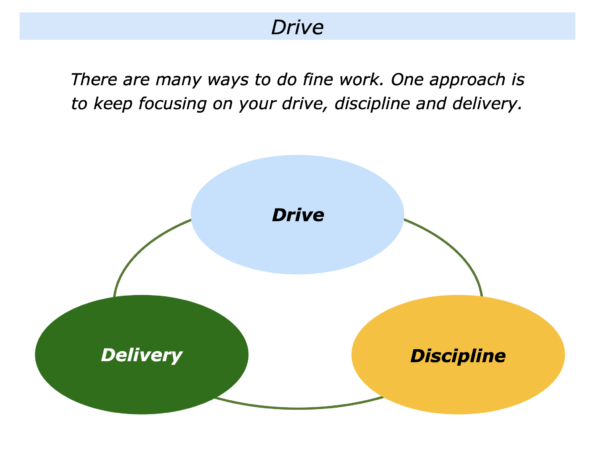
There are many ways to do fine work. One approach is to do what you do be best and focus on the following themes.
Drive – this involves following your drive and deciding how you want to translate this into action.
Discipline – this involves following your chosen disciplines and, when appropriate, also being daring.
Delivery – this involves doing your best and dealing with dramas on the way to delivering the goods.
Looking back, when have your followed some of these steps? You may have been pursuing a project, writing a book, playing a sport or doing another activity.
What did you do then to follow your drive? How did you follow certain disciplines? How did you do your best to deliver the goods? What happened as a result of taking these steps?
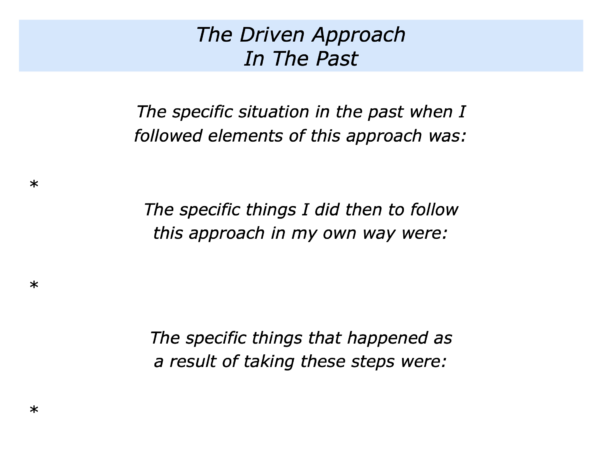
Imagine that you want to follow some of these principles in the future. Let’s explore how it is possible to take this route.
Drive
The process starts by focusing on something you feel driven to do. It then involves deciding how you want to translate this into action. You may then dedicate yourself to working to achieve a specific goal.
Different people follow their drive for different reasons. Some do it to satisfy their basic needs. Some follow it after having an epiphany. Some move forwards after a period of research and reflection. Here are some answers that people give when exploring this theme.
I feel driven:
To provide for my family … To help people to manage pain … To help young footballers to graduate from the academy to the first team … To design care homes that enrich the lives of people experiencing dementia … To pass on knowledge that helps people to succeed.
How can a person choose the theme they want to focus on? One approach is for them to ask:
What is the drive I want to pursue? What is the theme I keep returning to? How can I translate this into action? What is my picture of success?
Imagine you have provisionally settled on the drive you want to pursue. You may then move on to the next stage. Translating the drive into action.
Decision Making
Great workers take time to think before deciding to commit themselves to working towards a specific goal. Bearing in mind their drive, they explore the potential way forwards and do their due diligence. They then dedicate themselves to following their chosen route. Let’s explore these themes, starting with making decisions.
There are many models for decision making. Some people explore their possible choices, the consequences and the attractiveness of each option. They then decide on their chosen route.
Some people work through these themes logically. Some do it quickly and use strategic intuition. Gary Klein studied people who took this latter approach. His books on the topic include Sources of Power: How People Make Decisions and The Power of Intuition.
He studied firefighters and other professionals who made decisions in pressure situations. The following section draws on an interview he gave to Bill Breen for The Fast Company magazine. He explained what he had learned in the following way.
“I noticed that when the most experienced commanders confronted a fire, the biggest question they had to deal with wasn’t ‘What do I do?’ It was ‘What’s going on?’
“That’s what their experience was buying them – the ability to size up a situation and to recognise the best course of action.”
Gary explained that firefighters saw the big picture and looked for patterns. They then began exploring potential strategies.
They reached into their experience – their hyperdrive – to scan previous scenarios and see what lessons might apply to the present situation;
They chose a potential course of action and played scenarios – like running a film in their heads – to see this might work in practice;
They ran the film to see if the strategy would work and, if so, they began pursuing it.
Gary said that firefighters kept exploring various strategies until they found one that worked. He explained this in the following way.
“Once they make a decision, firefighters evaluate it by rapidly running a mental simulation. They might run through several choices, but they never compare one option with another.
“They rapidly evaluate each choice on its own merits, even if they cycle through several possibilities. They imagine how a course of action may unfold and how it may ultimately play out. They don’t need the best solution. They just need the one that works.”
Some people describe this approach in another way. They say that many gifted people are ‘raving intuitives who use selected logic’. The key is whether or not they make good decisions.
There are many other models for making decisions. Sean Kim wrote an excellent summary of several approaches for an article on The Muse website. Here are two of the best known tools.
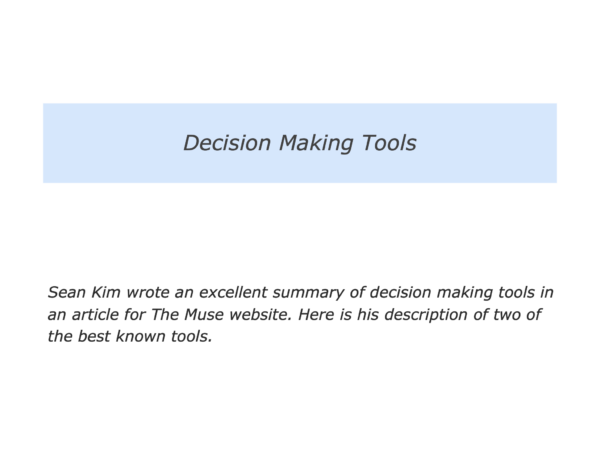
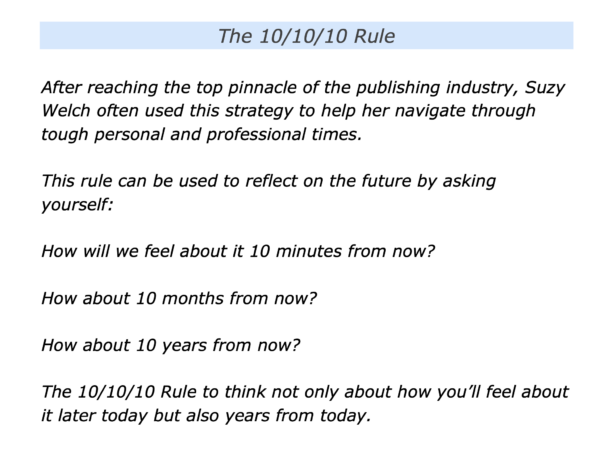
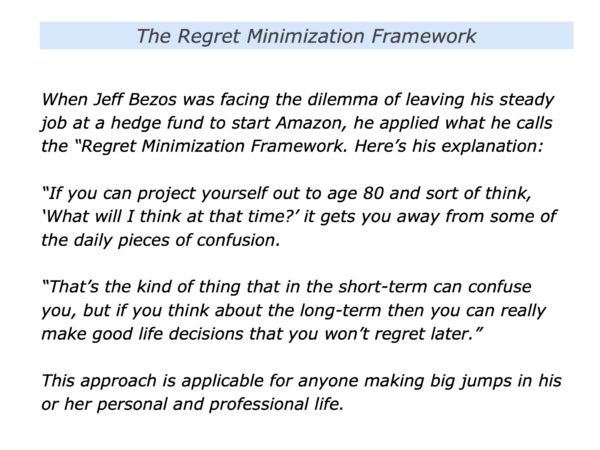
Imagine that you explored the possible routes you can take in the future. You may then want to focus on the following theme.
Dedication
Great workers commit themselves to doing their best and aiming to get positive results. This often involves them taking the following steps.
They clarify the route they want to follow, clarify the real results they want to achieve and translate this into a clear picture of success;
They clarify the key strategies they can follow to achieve the picture of success;
They clarify the pluses and minuses involved in doing the work and commit themselves to achieving the picture of success.
Great workers embark on their journey with their eyes open. They anticipate what can happen and decide if they are prepared to accept the whole package.
Imagine that you have clarified the thing you want to do, the strategies you want to follow and the desired picture of success. You have also considered the pluses and minuses involved in working towards achieving the goals.
Great workers often take one more step before dedicating themselves to achieving a specific goal. They check their motivation. This involves them working through the steps described in the framework below.
Looking at your own rating, make sure it is at least 8/10. You can also focus on how to maintain or improve the rating. This can include finding ways: a) to build on the pluses; b) to manage or minimise any minuses.
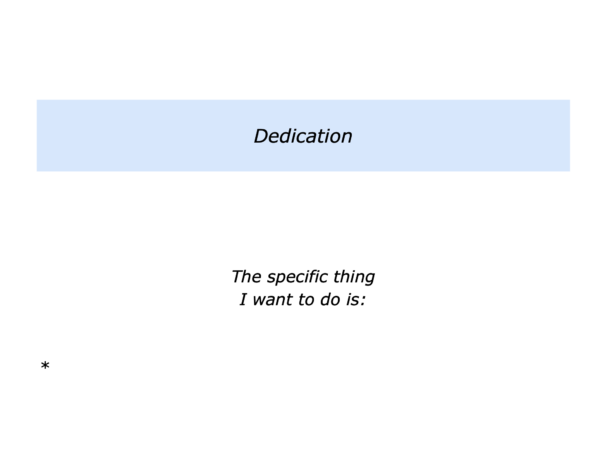
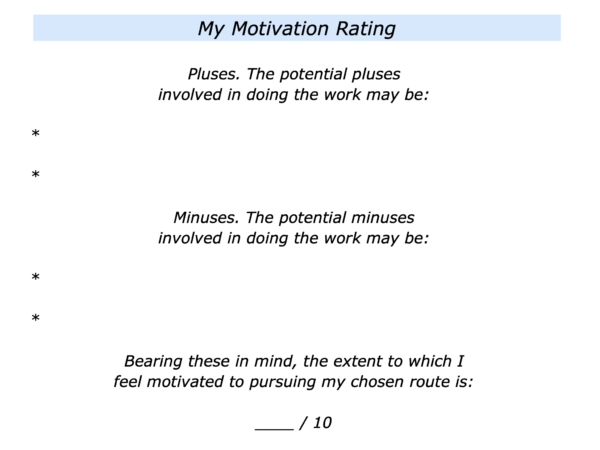
Discipline
Great workers take a delight in following certain disciplines. They also recognise that, when appropriate, they may need to be daring. They do this in a calculated way, however, to increase the chances of success.
Such workers often pursue their chosen discipline by following a certain rhythm. They aim to do the right things in the right way every day. Twyla Tharp, the American choreographer, believed in this approach.
Even into her sixties Twyla started the day at 5.30 am and walked out of her flat onto the Manhattan Street. She then hailed a cab that took her to the gym for a two-hour workout.
Writing in her book The Creative Habit, she explained how she followed certain rituals to develop good habits.
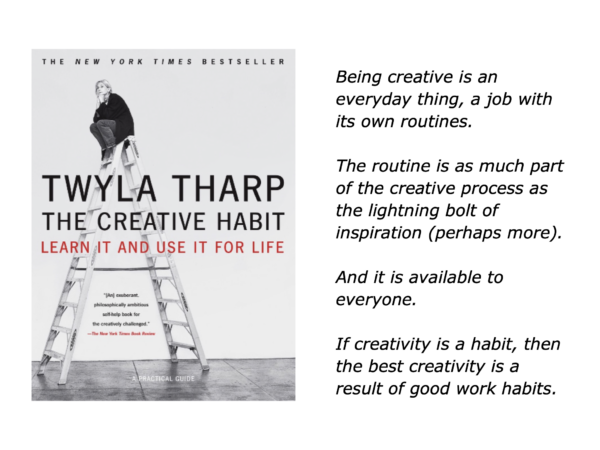
Great workers aim to keep doing their best when working towards their goals. Different people do this in different ways. One approach is for them to clarify the daily disciplines they can follow to deliver the goals.
They do their best to keep following their daily disciplines and also take the following steps.
They keep developing – they build on their strengths, clarify what they are doing well and do more of these things.
They deal with disappointments – they focus on what they can improve and implement these ideas.
They do their best to deliver the goods – they keep doing what works, keep improving and do everything possible to achieve the goals.
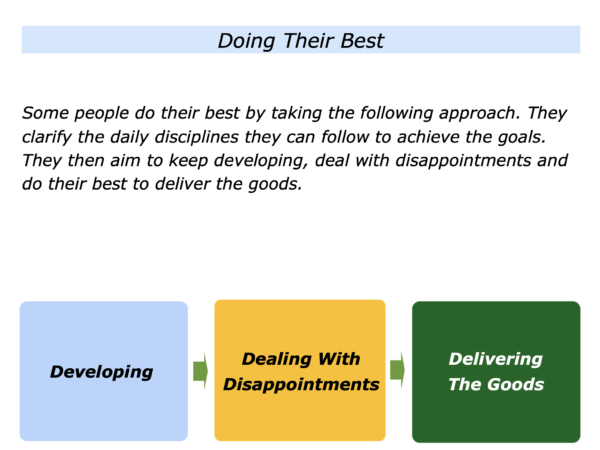
Some people keep on ongoing journal describing the specific things they are doing well and how they can keep improving. Here is one example.
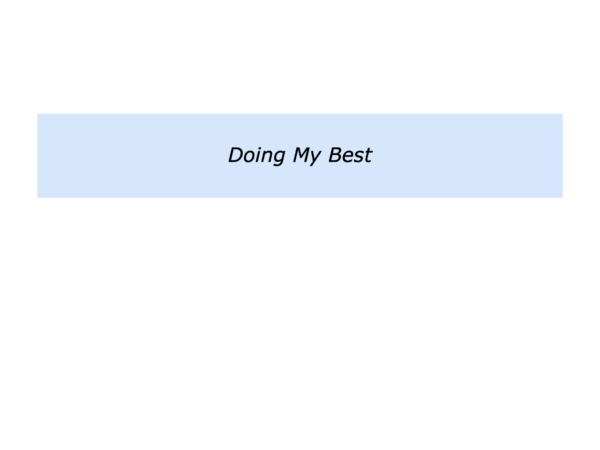
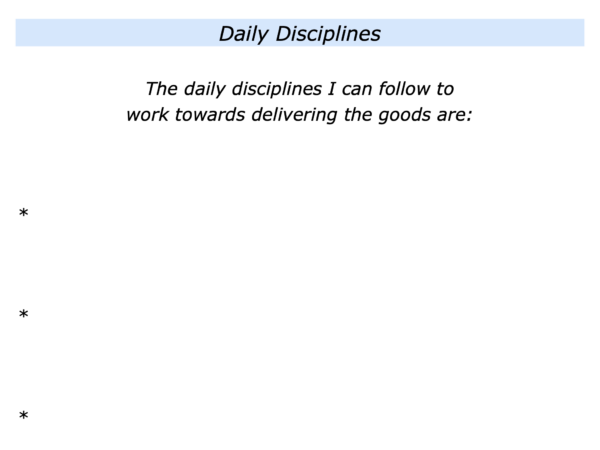
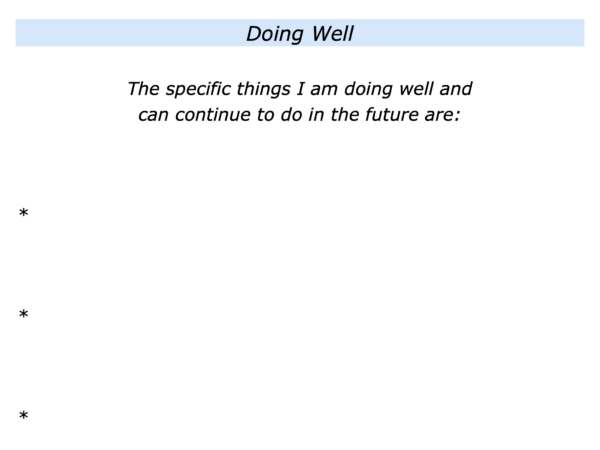
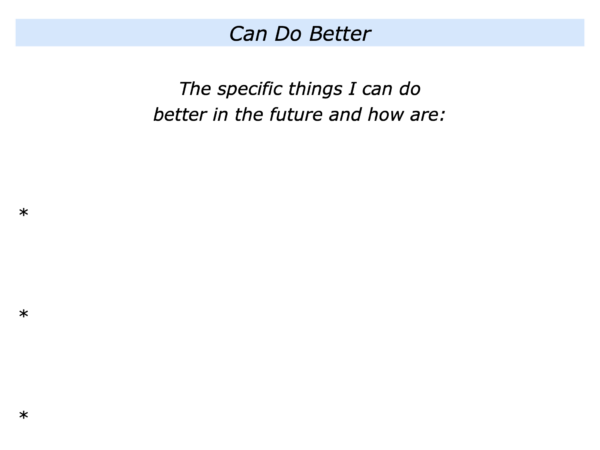
Daring
Great workers sometimes choose to be daring. They take this step in a calculated way, however, rather than by being careless. They recognise they may have more to win and less to lose by being daring.
They use their preferred decision making process to clarify the options for going forwards. They then dare to commit themselves fully to pursuing their chosen strategy.
The term daring rather than taking risks is one that I use deliberately. This encourages people to think in a more positive way rather than worrying about what they have got to lose. Let’s look at some of the motivations for being daring.

Some people choose to be daring because they aim to do something special. They may do this after following their disciplines but recognising that it requires something extra. They then build on their strengths and produce a superb piece of work that enables them to reach their goals.
Some people choose to be decisive rather than let things drift. They recognise that maintaining the status quo may lead to going into a negative spiral. Clarifying their options for going forwards, they then dare to pursue the route that is most likely to achieve the desired results.
Some people choose to be daring because they have nothing to lose. Such individuals can prove very difficult for opponents to deal with in sports or other activities because they are prepared to do almost anything to achieve their desired goals.
Let’s return to your own work. Whilst continuing to be disciplined, you may or may not need to be daring. At some point, however, you may move on to the next stage.
Delivery

Great workers keep doing their best. They keep following the strategies most likely to achieve success. They aim to make things as predictable as possible but sometimes they may need to manage other issues. Let’s explore one of these themes.
Dealing With Dramas
Such workers may need to deal with dramas on the journey. They then channel their feelings into working towards achieving the desired goals.
They do not get distracted by such issues or their own emotional ups or downs. They do not, when working in organisations, get caught up in turf wars or game playing. They do not get side-tracked by individuals who choose to be dramatic or have serial problems.
Such workers anticipate the potential dramas they may encounter on the journey. They then explore the follow themes.
How can I prevent these dramas happening? How can I deal with any dramas if, despite my best efforts, they do happen?
How can I buy time to think? How can I focus on the real results to achieve in the short-term and long-term? How can I do my best to find possible solutions to the dramas? How can I implement these solutions?
How can I return to following the required disciplines? How can I get a quick success? How can I continue doing good work on the way towards the destination?
Great workers regain their rhythm and continue to do good work. They do this because they have rehearsed how to prevent and manage dramas.
Let’s return to the route you may want to follow. Looking ahead, what are the possible dramas you may encounter? How can you prevent or manage these successfully?
Delivering The Goods
Great workers often demonstrate relaxed relentless. They are then more likely to flow on the way towards delivering the desired results. Let’s look at one person who applied elements of this approach
Chris Hoy – RidingThe Perfect Race
Chris Hoy, the Olympic cyclist, made a habit of setting big goals. Breaking these down into smaller targets, he focused on the step-by-step process of working to achieve these aims. This included visualising and riding the perfect race.
Chris gave an interview to Michael Johnson, who himself won four Olympic gold medals, for the video series Chasing Perfection.
In it he explained what he learned from working with Steve Peters, the psychiatrist who helps people to perform at their best. Here is a precis of what Chris said.
“I sought Steve’s help because I wanted to improve. One trigger was what happened at the World Championships in 2003. Then I changed my strategy based on watching a rival’s race and them doing an incredibly fast time.
“Instead of thinking that he was quick because of the track conditions – and therefore maybe we would all be quick – I changed the gears on my bike. I also attacked too hard at the start. This led to me dying off at the end and giving a really poor performance.
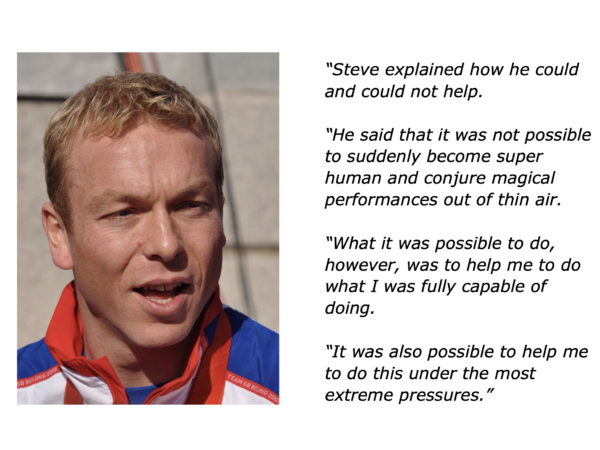
“This would be particularly relevant in front of Olympic crowds where there might also be many distractions. For me it would be about focusing on my performance. Anything that was irrelevant and out of my control, forget it.
“The key would be hone in on the A-B-C process that I knew worked rather than worry about the outcome. If you perform at your best and focus on the process, the result will take care of itself.”
He also describes how Steve prepared him to deal with potential challenges. Before one competition, for example, Steve asked him what he would do if one of his rivals went just before him and set a new world record.
Chris said that he did not want to think about such an issue. Steve explained that it was important to clarify how to respond to such challenges rather than ignore them.
Otherwise it is like somebody saying: “Don’t think of a pink elephant.” You immediately think of a pink elephant.
Steve urged him to practice how to take positive steps to deal with such potential issues. Chris explained this in the following way.
“Steve said that, from now on whenever you get a negative thought between now and the Games – there are only two weeks to go – I want you to visualise your race.
“It is only a minute long. Do it in real time, from the moment you are at the start gate. The count down, the deep breaths, the snap out of the gate, the first half lap. Visualise the whole race.”
“I got to the race on the night itself and it seemed like Steve had some sort of crystal ball. I was to ride last. With four riders to go, including myself, the guy broke the world record.
“Three riders to go another guy broke the world record. The guy before me broke the world record again.
“Instead of panicking and changing my strategy, I was so focused on myself and getting my ride out.
Chris went on to ride his perfect race. He focused on the process, performed at his personal best and won the prize.
Let’s return to your own life and work. Imagine that you want to do what you do best and follow your drive in the future.
How can you decide on the way forwards and dedicate yourself to this route? How can you follow the required disciplines? How can you, when appropriate, be daring? How can you deal with any dramas? How can you do your best to deliver the desired results?
If you wish, try tackling the exercise on this theme. This invites you to complete the following sentences.
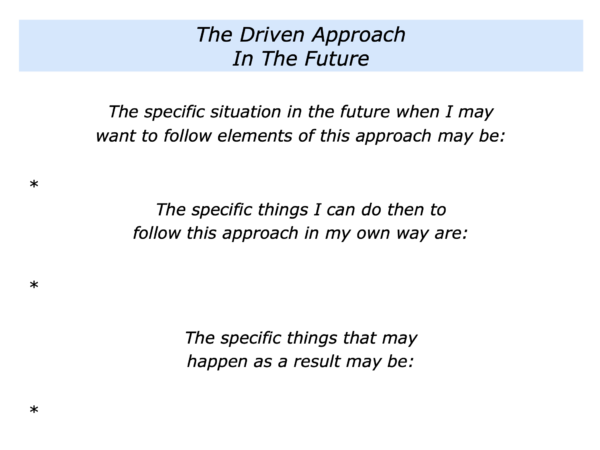






Leave a Reply